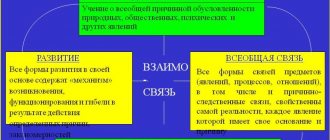Since ancient times, humanity has known a truly innumerable number of various philosophical sayings that reveal the characteristics of human nature and guide his behavior, one might say, making life easier in various life situations. Such great thinkers as Socrates, Plato, Aristotle, Demosthenes, Xenophon, Pythagoras and many others spoke on similar topics. And in our modern times, you can find many interesting thoughts, for example, a special methodological principle called “Occam’s Razor,” which received its name in honor of the English philosopher and Franciscan monk William of Ockham. Let's talk about this very Occam's Razor.
What is Occam's Razor?
The postulate in question is expressed in the words “Do not produce entities”
, or
“New entities should not be multiplied (multiplied) unnecessarily
.
More modern versions are: “If you have two equally effective ways to solve a problem, choose the simplest one
,” or
“The simplest explanation is likely to be more accurate than the more complex one
.
In other words, the simplest explanation is preferable to the more complex one. In any incomprehensible situation, you should first of all focus on simple solutions, and reject more complex actions (at least until easier ones have been tried), “cut off” with a conventional razor. Let's return to our example with the operator: when asking you about rebooting the equipment, he chooses the simplest path. And if a reboot does not help, it will begin to sort through and cut off other options - from simple to complex.
Important: Occam’s razor is not a statement, but a so-called maxim. In itself, it does not prove or disprove anything, but only serves as a tool for confirming and challenging
.
This philosophical postulate is based on two principles:
- The principle of economy
, which states that it is better to do something with less effort than to put in more effort. - The principle of plurality
- if you can get by with a small number of actions, you should do so.
Historical excursion
In the publication “Ockam. Philosophical Writings. A Selection Edited and Translated by Philotheus Boehner” (New York, 1957), a specialist in the history of medieval philosophy Boehner Philotheus reports that the author often gives Occam’s razor in the following formulation:
“One should not assert much without necessity” (Latin: Pluralitas non est ponenda sine necessitate). Ockham put it more clearly:
...multiplicity should never be assumed without necessity... [but] everything that can be explained on a number of grounds from the difference of matter - this can be explained equally well or better with the help of one reason.
Sometimes the principle is expressed in the words “What can be explained by means of less need not be expressed by means of more” (Latin: Frustra fit per plura quod potest fieri per pauciora).
Common formulations of a similar principle “entities should not be multiplied unnecessarily” - lat. Entia non sunt multiplicanda sine necessitate or lat. Entia non sunt multiplicanda praeter necessitatem - do not appear in Occam's works. The first formulation is recorded for the first time in the commentary of the Franciscan John Pons (Johannes Poncius) to the edition of Duns Scotus's Opus Oxoniense in 1639. The second formulation was first noted in 1654 by the German philosopher Johann Clauberg.
Ockham himself formulated this principle, apparently, primarily to confirm the existence of God.
History of appearance
The maxim in question is associated with the monk and philosopher William of Ockham
(that is, from Occam's village), who wrote in his works: "What can be done on the basis of fewer assumptions should not be done on the basis of more assumptions."
But in fact, this idea was not discovered by him; he only reformulated a saying that was used by Aristotle in the 4th century BC.
e. The name of the technique comes from the name of a small English village in Surrey.
Officially, Occam's razor appeared later, and the clergyman did not suspect that the technique would be given his name. The razor in the title is mentioned as a tool for cutting off unnecessary entities. The latter were understood as any theories/facts/assumptions that do not have empirical confirmation
, that is, evidence obtained as a result of experiments, observations or other actions that can be recorded using the senses.
The method is sometimes called Occam's blade, and also called the Principle of Thrift or the Law of Economy.
It is interesting that Ockham himself wanted to prove the existence of God with the help of a “razor”. He wrote that "nothing should exist without an explanation of a cause, unless it is self-evident or proven by the pages of Holy Scripture." Occam believed that an explanation is not valid unless it is proven by experience, the Bible, or contradicts common sense. At the same time, he was confident that the existence of God is undeniable, because religion is based on faith, not on evidence, and in this matter he did not rely on science.
Brief biography of William of Occam
The philosopher was born around 1284 in Ockham (England).
As far as is known, he was very young when he entered the Franciscan Order. His studies at the Franciscan monastery focused on the study of logic, and throughout his life his interest in the subject never waned.
The Franciscan friar received a degree in theological studies from Oxford University. It is believed that he is baccalaureus formatus, that is, a candidate for master of theology.
In the autumn of 1324, he left England and went to France (Avignon), Pope John XXII called him to account for charges of heresy. Ockham was not officially condemned, but in 1328 he was excommunicated.
It was long believed that Ockham died in a monastery in Munich in 1349, during the Black Death (also called the Black Death). But perhaps he died there even earlier - in 1347.
How to use the method
Is it possible to use a philosophical presumption in the realities of modern life? Yes, as a tool for making decisions and choosing an algorithm of actions
.
If you don’t know what to do or what to choose, Occam’s blade can tell you which direction to move in – at least at the beginning of your path.
This principle can also be used to construct a theory or explanation in the absence of evidence. Until you have verified facts, you can accept the simplest solution that describes what is happening as the truth. This implies that this conventional theory must be modified according to emerging evidence.
Application to questions of origin
Figure Wikipedia.org William of Occam
Let's look at Occam's Razor as it applies to two theories of origin, namely, evolution and creationism, and especially to the answers to some of the fundamental problems that each of these theories purports to explain without losing its credibility. First let's look at the evolutionists' dilemma.
1. Where did matter and energy come from?
If someone says that matter and energy have always existed, then, following logic, eternal existence should have been inherent in the universe. But the universe is running out according to the Second Law of Thermodynamics, so sooner or later heat death will occur, in which everything in the universe will reach the same temperature, a few degrees above absolute zero. If the universe had existed forever, heat death would have occurred a long time ago, but this did not happen. Therefore, the universe is not eternal, and it must have had a beginning.
If someone says that matter and energy are the result of the supposed big bang, then let him also explain where the energy for the big bang came from? If someone says that it came from a “cosmic egg,” then the answer will be many questions to which evolutionists have no answers, and will also require a sea of assumptions.
For example, where did the energy of the “cosmic egg” come from? What made it shrink into one dimensionless point (“singularity”, which is simply a replacement for the word “nothing” 7
)? What gave the impetus to the expansion of “nothing”? If gravity was almost infinite and the "single point" was a black hole, why did everything start expanding? How did this explosive expansion produce all the order in the universe? And so on…
2. Where did life come from?
Next time you eat a can of beans or canned fruit, think about why you haven't died from food poisoning yet? The fact is that a tin of food, after it has been sealed, is sterilized by high temperature, which kills all the bacteria inside. After all living things have died, new life does not come from inanimate matter.
This is the essence of the law of biogenesis: life generates life, but inanimate matter does not generate life. Another place where this law can be seen in action is in a hospital operating room. The principle of asepsis (sterilization), arising from the works of Pasteur, Lister and other scientists, is associated with the fact that if once all life has been destroyed, inanimate matter does not and cannot give birth to new life.
The question then arises, where did life come from? The usual answer from an evolutionist is that life arose from the random combination of atoms and molecules in a primordial soup. (Francis Crick's view, called the panspermia theory, suggests that life was brought from another part of the universe. However, his view simply relegates the problem of the origin of life to the obscurity of the cosmos.) But this approach involves many assumptions and contradicts well-proven principles, such as the law of biogenesis, which we confirm daily as mentioned above.
3. Where did the information come from?
Living beings are full of information, recorded mainly in their DNA. This specific information determines how to produce and use all the components of a living organism, how to ensure reproduction, etc. In the human body, the DNA molecule contains about 3 billion “letters” of text information with a plan for the synthesis of 100,000 different proteins, as well as much more that science has not yet is not known (for example, how embryo development is controlled).
This type of information contains a certain meaning and meaning. For example, the sequence of letters "oanvl libome myns kra otva dete tom melib" has no meaning and does not mean anything, so there is little to suggest that anything more than a random process produced it. 8
But if someone rearranges the same letters and puts together the phrase “she owns a red car,” we immediately see the information produced by the mind.
Evolutionary or other random processes (such as natural selection) cannot produce the enormous amounts of information that are necessary for the life of living beings.9
The assumption that they can do this is completely unfounded. More information on this topic can be found in the section: Information Theory, Questions and Answers.
4. How do changes happen?
If, according to evolutionary theory, an animal needs to develop a certain organ (for example, a dinosaur grows wings to avoid predators), such an organ does not provide a survival advantage during the intermediate stages of its development. An animal whose front legs have become partly legs and partly wings will no longer be able to run as fast as before and will not yet begin to fly. Therefore, the probability of survival of such an animal will be lower, and by definition (the fittest survive), such intermediate forms will be destroyed. How will new forms be formed under such conditions?
How to apply Occam's blade in practice?
Despite the fact that Occam's blade is a philosophical, theoretical postulate, it also finds application in everyday life.
Choose the simplest explanation, solution, algorithm of actions
Let's imagine a situation in which the same phenomenon can be explained:
- using three entities (facts, phenomena, terms, rules);
- with the help of four entities.
If both of the above solutions lead (or could potentially lead to the same result as a result of your actions), you should choose the first one.
Example
Let's assume that your network cable is malfunctioning. Externally, it is intact, it has not been pinched or cut anywhere, so most likely the problem is in the connection point: either with the computer or with the router. At the same time, the router is within reach (one entity - take it and check), and in order to check the connection with the system unit, you need to move the bedside table, crawl under the table, untangle the tangle of wires, find the desired connection in an awkward position... (many entities). It is logical that in such a situation you should first check the connection to the router.
Choose the simplest and most logical explanation
First of all, it is necessary to exclude overly complex options.
, requiring a conglomeration of entities.
Also, assumptions that cannot be confirmed empirically
are removed: observation, measurement, etc. In other words, everything that is not perceived by the senses or is too complex an explanation of the existing facts should be cut off here.
Example
Let's say we wondered why it gets dark at night. We explain this by saying that the Earth revolves around the Sun, and when one of its sides turns towards the sun, the other plunges into darkness, so night falls.
But we can imagine a more interesting option: once a day, a giant dragon living in the sky steals the Sun and hides it in a bag, and after a few hours the reptile gets hot, and it releases the giant fireball back. But after a while she tries to steal the sun again, and so on in a circle.
Based on Occam's philosophy, the last idea should be cut off, because it is nothing more than a heap of entities. We already have a simpler explanation, based on many years of observation of celestial bodies by scientists. This is exactly what is true.
In addition, we exclude entities that are not perceived by the senses, and no one has ever seen a dragon with a bag.
Validity of the Supernatural
Book by Stephen Hawking
Does the principle of Occam's razor remain valid when talking about the supernatural? Apparently, atheists think so. The Skeptics' Dictionary says, "atheists often invoke Occam's razor as an argument against the existence of God, arguing that God is an unnecessary hypothesis." 5
And in his best-selling book A Brief History of Time, Stephen Hawking, discussing the uncertainty principle, writes:
“Of course, we can imagine the existence of a set of laws that determine all events for some supernatural being, who, in turn, observes the current state of the universe without disturbing it. However, such models of the universe are not particularly useful to us mere mortals. We might be better off remembering the principle of parsimony known as Occam's razor and cutting off all those aspects of the theory that cannot be observed." 6
However, when skeptics bring Occam's Razor to the table, they are putting a rod on their own back, because, as we will see, once the value of Occam's Razor is accepted and this criterion is used in the creationism-evolution debate, creationism clearly wins not evolution.
Is Occam's razor universal?
Unfortunately, this method cannot be called universal. The main disadvantages of Occam's razor
:
- Subjectivity of opinion
There are disagreements regarding what is considered simple, since this is a subjective concept. - Simplicity is not always the same as truth.
Often, an elementary explanation or solution to a problem is incorrect.
Sometimes using a razor leads to a dead end
. For example, believers may appeal to the concept of Occam's razor to prove the existence of God - because it is easier to accept that he created the world around us than to think that the complex and orderly universe around us was the result of the Big Bang. But atheists can also say that it is easier to explain the creation of the world using the laws of physics than to resort to using another entity - God.
In addition, any conspiracy theories are strictly cut off with a razor.
, because the explanations of those who believe in them tend to be complex and involve a large number of participants.
In 1983, a group of scientists from Oxford developed the Occam programming language, named after the philosophical principle. His goal was to keep the coding process simple.
Illustrative examples
Albert Einstein paraphrased Occam's razor principle. He called for simplifying while there is such an opportunity. There is also a more modern version: the most accurate message is the minimum length.
Let us give examples of the operation of Occam's razor. The thinker Plato was asked who a person is. The answer was more than interesting: a person is an animal with two legs, but without feathers. After such an explanation, Diogenes brought a plucked rooster to the Academy. He declared that this was the man Plato had mentioned. The latter corrected his description, adding only one phrase: “With flat nails.”
Another example of Occam's razor in action was shown by the mathematician Laplace. Napoleon became interested in why Langrage (a famous French scientist) did not mention the word “God”, often used in conversation, in his writings. Laplace said: “This is because I did not need this hypothesis.”











